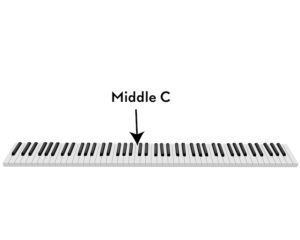Learning Songwriting – Chords
There are three parts to any piece of music: melody, rhythm and harmony. Most of us can sing along to a song, thus we are engaging in melody and rhythm. Harmony is the tricky one.
Harmony refers to the chords that underscore the melody. It can go from very simple to very complex. There are famous songs such as Chain of Fools that contain a single chord, all the way up to jazz artists that use extremely complex chords and harmony.
The Major Scale
Most popular songs are rather simple and we can learn their chords and how they work pretty quickly.
Let’s start with the C major scale. Looking at the image below you can find middle c. If you play just the white keys step-by-step up the keyboard you will hit seven notes before you come to C again. Everything starts again just an octave higher.
The names of the notes as you go up are CDEFGABC. We are going to drop the letter names and give the notes a number. C=1, the next note D=2 and so on, all the way to the upper C which we will call 8.
Creating Chords
We can use this numbered scale to start building chords.
Simple chords contain 3 notes and are called triads. These notes are made up of 1-3 and 5. They are also called the root, 3rd and 5th of the chord.
If we start with middle C as #1 we now need to add a 3rd. If C is 1 then D is 2 and E is 3. We need to add the E.
We now need a 5th. Counting up from E brings us to G at the 5th scale degree. CEG = a C major chord. This is also called the I chord since its root is the first scale degree.
We can use this simple formula to build chords starting on every note of the C major scale.
Go up a step to D. Now add a 3rd and 5th starting from D. This will give you DFA. This is the II chord.
A triad built from E is the III chord, from F is the IV chord and so on.
Major and Minor
If you listen to these chords closely you will notice they have different musical flavors. The I chord is quite happy and settled whereas the II chord sounds a bit sadder. This is because the II chord is a minor chord.
Major and minor chords are the two dominant sounds in music. The difference between them is the 3rd of the chord. An A minor chord has a 3rd that is a half-step lower than a major chord.
To experience this, play the C major chord we built earlier. Now move the 3rd or E to the next lowest black key or Eb. You now have a C minor chord. You should be able to hear the difference clearly.
As we create chords out of our C scale we will get the following major and minor chords.
I chord is major
II chord is minor
III chord is minor
IV chord is major
V chord is major
VI chord is minor
The VII chord becomes what is called a diminished chord and is not used anywhere near as often. We won’t worry about it right now.
So Few Chords – So Many Songs
You will notice that in the chords we created from the scale there are three that are major. These are the I, IV and V. These three chords appear in more songs than any other. In fact with just these three chords you could play hundreds of popular songs. These songs include Amazing Grace, All Shook Up, La Bamba, Rock Around The Clock, Twist and Shout and many more.
If we add one more chord the minor VI we get another great crop of songs. In fact the chord progression I-V-vi-IV is used so often that people have created comdey routines about it.
Songs with this progression include Don’t Stop Believing, Edge Of Glory and Let It Be.
Notice that I wrote the VI chord in lower case (vi), this denotes a minor chord. Upper case usually means a major chord.
These chords and scales can also be used in other keys. The key of E would have E as the I chord, A as the IV and B as the V.
It’s Your Turn
You are now in possession of as much musical knowledge as the composers of some of your favorite songs.
Sure music can be far more complicated than this, but these chords can give you a start in writing your own songs, which is frankly one of the most artistically satisfying things you can do.
